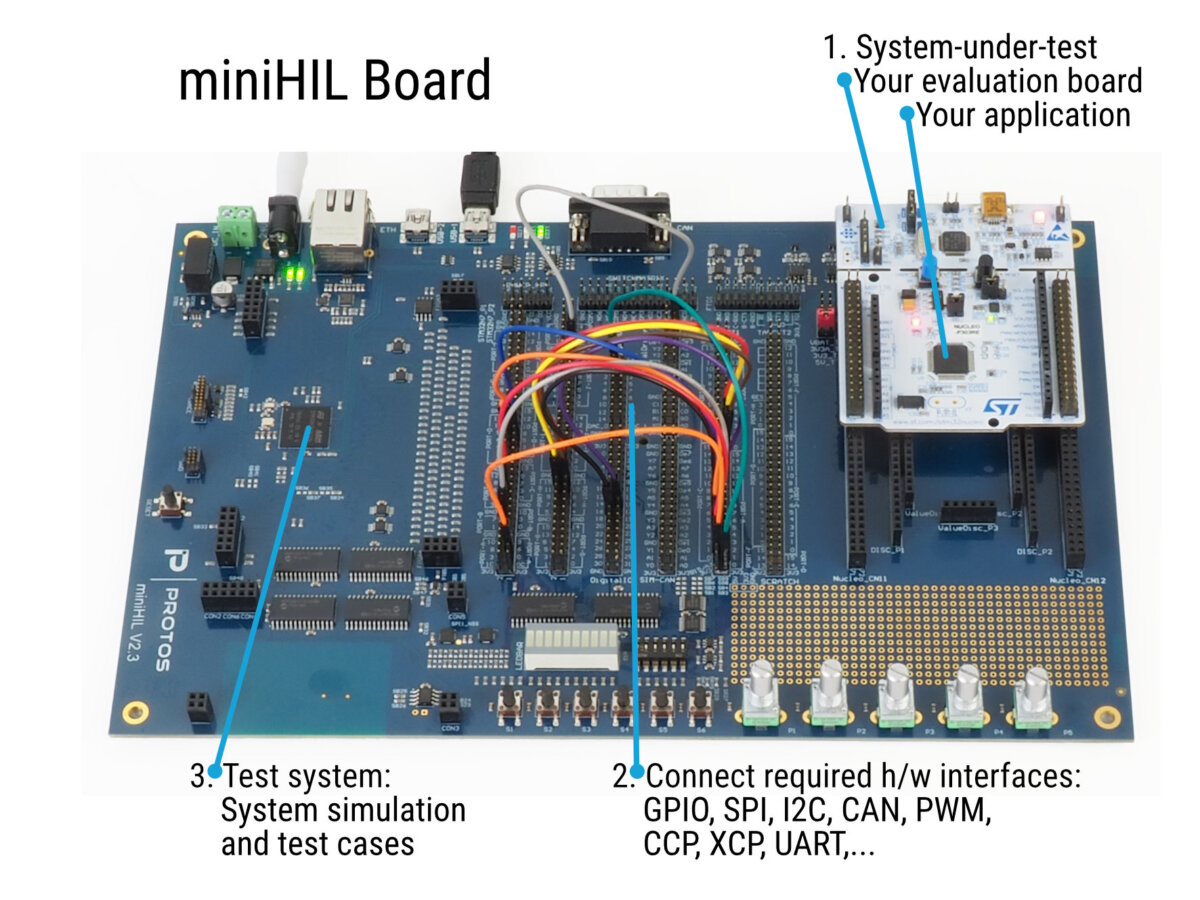
miniHIL – Hardware in the Loop Test for Embedded Systems
Why miniHIL?
With PROTOS miniHIL you can test embedded systems early and easily. Already from development on evaluation boards, testing and simulation is done continuously.

miniHIL for Integration Testing
In the early stages of development, embedded systems are usually not tested or only tested to a limited extent.
Why is this so?
- The target electronics are often not yet available. Development takes place on evaluation boards, for which there are typically no test systems.
- The usual hardware-in-the-loop test systems are often too large and too expensive to allow continuous testing during development.
- Test systems in combination with simulation elements are technically complex and difficult to automate.
- Unit tests are poorly suited for testing hardware-related, concurrent or asynchronous functions (e.g. drivers and motor controllers).
The PROTOS miniHIL closes this gap.
How does the miniHIL work?
The PROTOS miniHIL is a complete solution consisting of the miniHIL hardware board and a software platform for simulations and test cases.

miniHIL Hardware Setup
The setup of a test system consists of the following steps:
- Plugging in your evaluation board as a system-under-test. This means that your embedded application is already running on the correct microcontroller.
- Connecting the hardware interfaces of the system-under-test to the test system.
- Development of environment simulations and test cases running on a powerful embedded processor (STM32H7).
miniHIL test development
The tests and environment simulations for the miniHIL are developed in a model-driven manner. The basis for modeling is the open source tool Eclipse eTrice, which enables structure and behavior modeling and code generation. CaGe test models can be seamlessly integrated into the eTrice models. The combination allows the easy construction of models that include both simulation and testing.
A miniHIL model consists of the following parts:
- Adapter library to control the hardware interfaces (eTrice models)
- Simulation and monitoring elements based on the hardware interfaces (eTrice models)
- Your test cases can access the hardware interfaces directly as well as the simulation and monitoring elements, e.g. for fault injection (CaGe models).
Use cases for the miniHIL
The miniHIL is excellent for testing from the point where integration testing is needed. Examples can be found here:
Test for all typical microcontroller applications.
- Test for STM32 systems
- Test for Infineon TLE systems
- Other microcontrollers on request
Driver Test
- Peripheral driver tests for microcontrollers
- MCAL Test for AUTOSAR
Test and simulation for motor control software
- BLDC and DC motor control
- Universal motor control
- Sensorless motor control: Single Shunt / Dual Shunt
- Motor control with sensors: Hall / angle sensors
Environment simulation
- Sensor simulations e.g. temperature, acceleration
- Battery and battery management simulations
- Building block simulations e.g. flash, RAM, gate-driver
- Interface simulation via SPI, I2C, UART, analog, digital, …
Rest bus simulation
- Test for CAN Bus protocols
- Test for LIN Bus protocols
- Test for TCP/IP protocols
- Test for UART protocols
- Test for XCP protocols
Other
- Commissioning and development of microcontroller software (stimulation and monitoring)
- Test of project specific protocols
miniHIL Features
Test levels
- Component test for drivers and hardware-related software
- Integration test for embedded applications
- Simulated system test
- Acceptance test
Test system modeling
- Modeling of test and simulation environments with eTrice
- Test Case Modeling and Generation with CaGe
- Combinatorial test case generation with CaGe
- Adapter libraries for hardware interfaces
Reporting and Traceability for HIL Tests
HIL Test Automation
- Test automation at the developer’s or tester’s workplace
- Test Automation with Continuous Integration
- Command Line Interface for Test Automation
All technical documentation is located online in the miniHIL UserGuide..
Learn more about the miniHIL
We’re happy to advise you!
If we have piqued your interest but your questions about the miniHIL are not yet fully answered, please contact us – we’re always happy to help!

